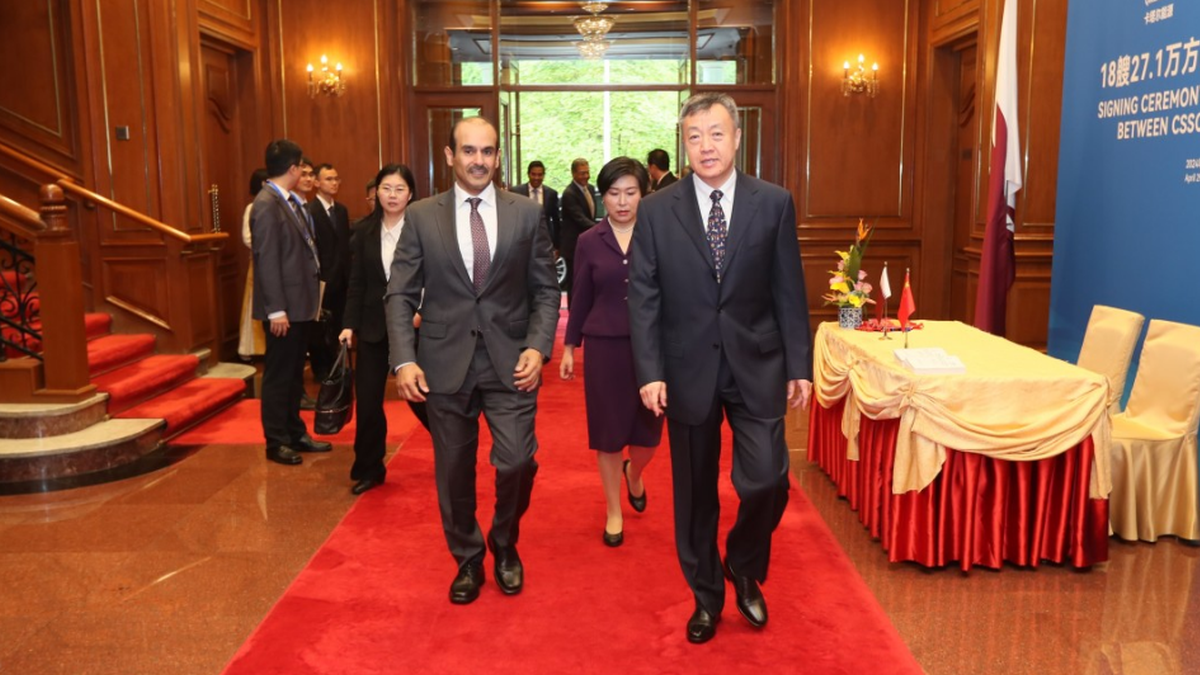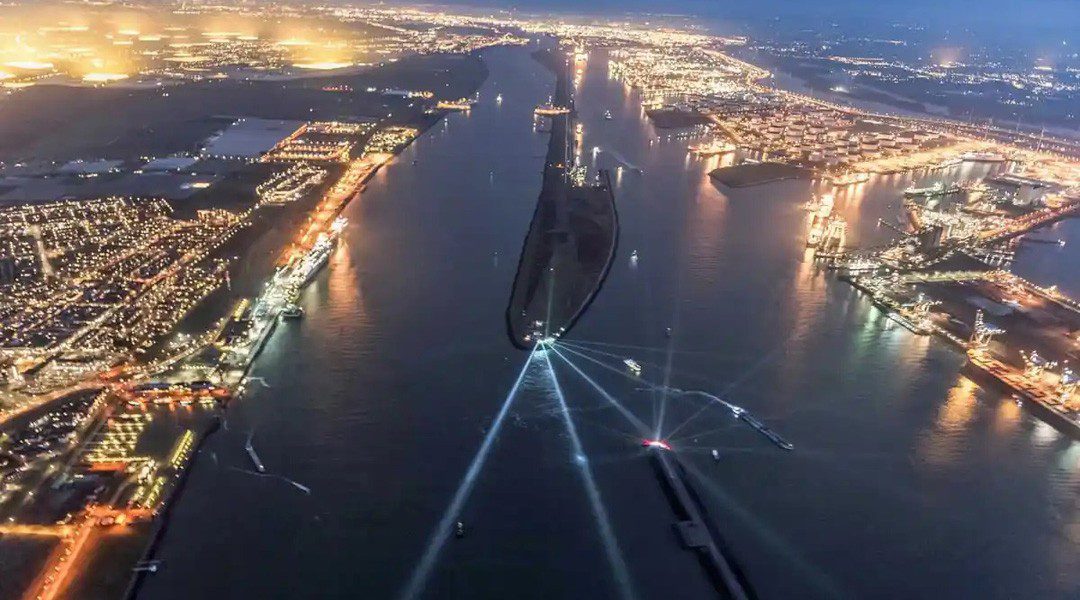 CSSC said it had held a signing ceremony in Beijing brimming with Chinese and Qatari state officials, including Qatar’s Minister of State for Energy Affairs and president and CEO of Qatar Energy, Saad Sherida Al-Kaabi (source: CSSC)
CSSC said it had held a signing ceremony in Beijing brimming with Chinese and Qatari state officials, including Qatar’s Minister of State for Energy Affairs and president and CEO of Qatar Energy, Saad Sherida Al-Kaabi (source: CSSC)
Shipbuilder China State Shipbuilding Corp (CSSC) says the order for 18 Q-Max sized LNG carriers is the largest single order for newbuild vessels in history
CSSC said it had held a signing ceremony in Beijing brimming with Chinese and Qatari state officials, including Qatar’s Minister of State for Energy Affairs and president and chief executive of Qatar Energy, Saad Sherida Al-Kaabi.
Speaking at the event, Mr Al-Kaabi said the two companies had signed a construction contract for 18 of the largest-capacity LNG carriers on the water, so-called Q-Max vessels, each capable of holding 271,000 m3 of liquefied natural gas and equipped with an on board reliquefaction system. The vessel type Q-Max indicates that they are the largest vessels Qatar’s LNG terminals can accommodate.
According to CSSC, the LNG carriers will be independently designed and built by CSSC subsidiary Hudong Zhonghua. The ships will have a total length of 344 m, a molded width of 54 m, a molded depth of 27 m, a design draft of 12 m, and will run on dual-fuel low-speed engines.
CSSC said the vessels’ carrying capacity is increased by 57% compared with “conventional” 174,000-m3 capacity, large LNG carriers.
“In terms of performance… the energy consumption of cargo transport per tonne nautical mile is almost 10% lower than that of a 174,000-m3 LNG ship,” CSSC said. “The carbon intensity index (CII) is 23% lower than that of a 174,000-m3 LNG ship. It can flexibly match various operating [configurations for] different routes, [and] in terms of compatibility, the draft and cargo design are diversified and optimised, covering all major mainstream routes.”
The vesels’ tanks will include enhanced insulation modules, come equipped with a real-time sloshing monitoring system, and the vessels will have hull configuration stress monitoring and an anti-collision system.
Media reports have priced the vessels at approximately US$310M each, a figure that would take the total contract value for the 18 vessels ordered above US$5.5Bn. The build schedule for the vessels will reportedly see them delivered between 2027-2029.
Rumours of contract negotiations for the vessel order have been widely covered since QatarEnergy booked eight slots at Hudong-Zhonghua shipyard in January 2024. The Q-Max LNG carrier designs are expected to be based on the 271,000-m3 design for which the shipyard received an approval in principle from DNV at shipping industry trade conference Gastech in 2023.
At the Gastech event in 2023, DNV global business director, gas carriers and FSRUs, Martin Cartwright, said the AiP “represents Hudong-Zhonghua’s ability to create a cutting-edge design for the largest LNG carriers.”
The new LNG carrier design is 344 m long, with a beam of 54 m and five cargo tanks. To maximise the vessel’s energy savings and safety, it incorporates an air lubrication system and shaft generator, and a cargo tank design with sloshing monitoring, as well as an advanced anti-collision system. DNV notes that despite its size, the LNG carrier would be able to berth at more than 70 LNG terminals along the main trade route, increasing its commercial flexibility.
In February 2024, QatarEnergy announced it is proceeding with a new LNG project, the North Field West Project, as part of its massive North Field Expansion (NFE) that will raise Qatar’s LNG production capacity from 77M tonnes per annum (mta) to 142 mta before the end of this decade, representing an increase of almost 85% from current production levels.North Field West joins two other NFE projects in North Field East and North Field South. Between them, the two projects already were set to push the Middle East state’s LNG liquefaction capacity from 77 mta to 126 mta.
To support this massive liquefaction production expansion, QatarEnergy is in the second phase of an historic LNG carrier newbuilding programme. These LNG carriers will not only support offtake from the NFE projects, but also the Golden Pass LNG export project in the US, and QatarEnergy’s long-term fleet renewal requirements.
Earlier in April 2024, QatarEnergy announced that its fleet expansion programme had officially suprpassed 100 vessels, with the signing of charters for 19 additional LNG carriers with China Merchants Energy Shipping (CMES), Shandong Marine Energy, MISC Berhad and a K-Line-Hyundai Glovis joint venture taking Qatar’s total orders to 104 LNG carriers.
The 15 vessels set for charters with CMES, Shandong Marine Energy and MISC Berhad will be built at Samsung Heavy Industries in South Korea while the four vessels set to go to the K-Line-Hyundai Glovis’ joint venture are to be built at Hanwha Ocean (formerly Daewoo Shipbuilding & Marine Engineering) in South Korea. All 19 conventional LNG vessels will have a capacity of 174,000 m3 once built.
Nakilat long-term charter deal
On 24 March 2024, QatarEnergy inked a time-charter party (TCP) deal with Qatar Gas Transport Co Ltd (Nakilat) for the operation of 25 174,000-m3LNG carriers as part of the second shipowner tender under its fleet expansion programme.
The TCP deal follows an announcement in February 2024 thatNakilat would operate up to 25 vesselsfor the Qatari LNG expansion efforts.
While QatarEnergy has reserved the shipbuilding slots, these LNG carriers will be owned or operated by international shipowners under 10- to 15-year TCP agreements. The ship orders had been conditional on the signing of TCPs by affiliates of QatarEnergy and Nakilat.
All of the 25 vessels are being built in South Korea, withHyundai Heavy Industries shipyards under contract for 17 vesselsand theremaining eight being built at Hanwha Ocean.





